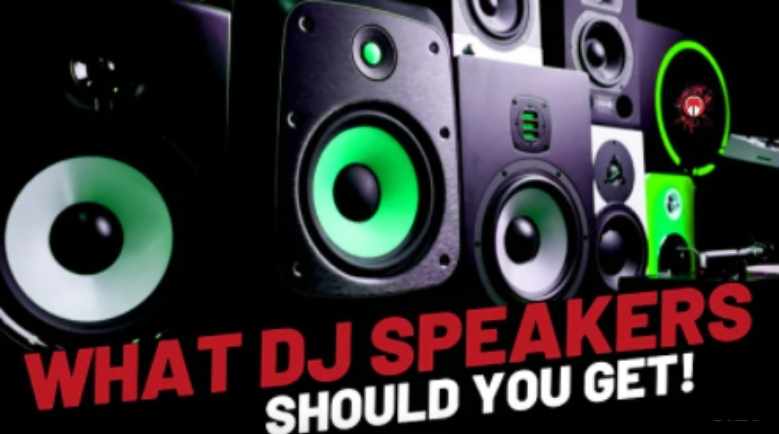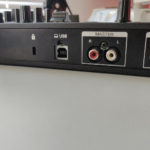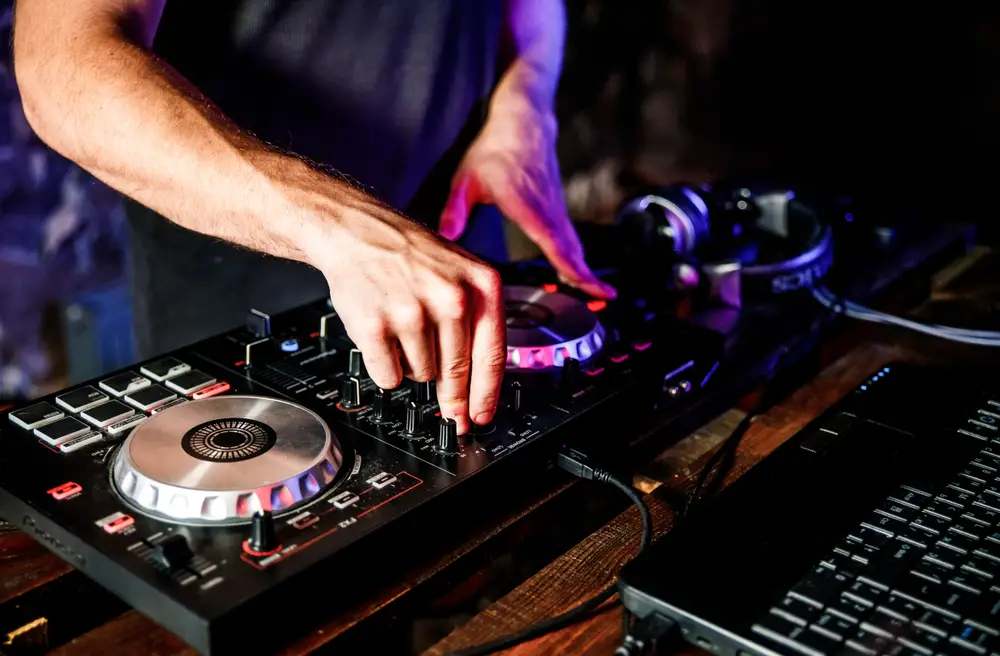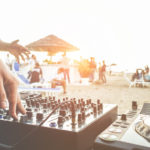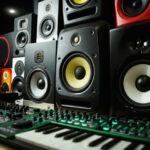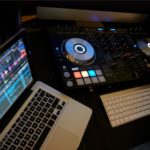So, you have your DJ controller of choice, you have your songs loaded up, headphones on, now you just need a speaker to unleash your sonic powers on the crowd.
If you are new to DJing, some of the hardware required can be quite confusing, especially if you don’t have a technological background or haven’t dealt with this sort of gear before.
Going to your local tech store could be quite daunting as the store assistant throws jargon and numbers at you which you don’t understand.
Moreover, you don’t want to embarrass yourself in front of your fellow DJs by playing your music through a tin can, but you also don’t need to spend an arm and a leg on a surround sound club-level system. It’s all about finding the right fit for your needs.
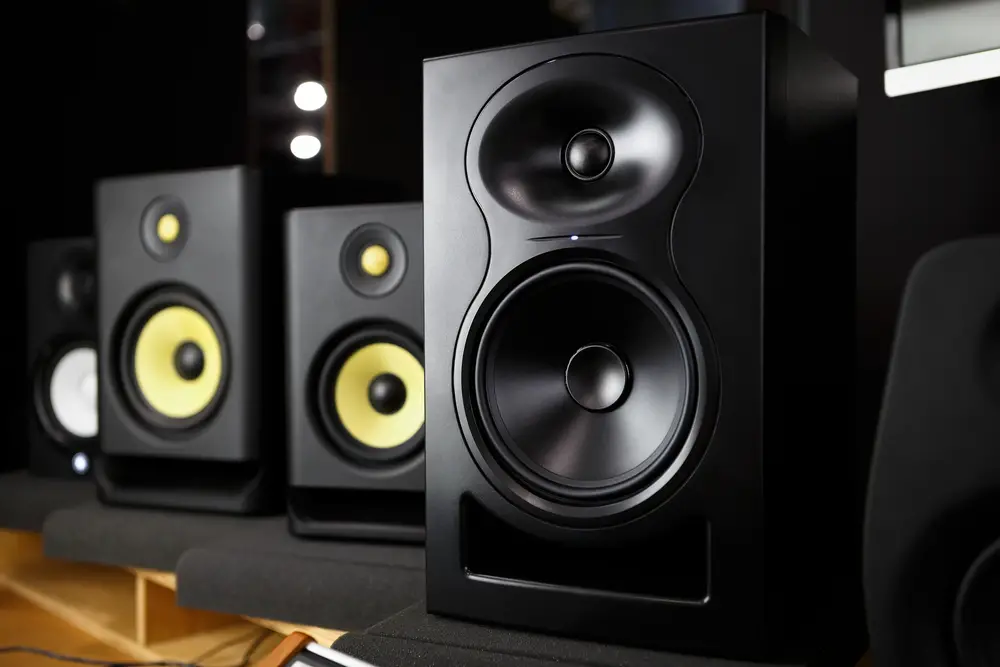
As a DJ, you need a good set of speakers so you can effectively equalize the songs and hear each integral part of the song – the lows, the highs, and the mids.
Your mixing skills won’t get the praise they deserve if you have a sub-par speaker, so do both you and your crowd a favor and read on to figure out what kind of speakers you need.
The Basics
When you are buying your speaker there are a few fundamental things you need to understand to make sure you are buying the right gear.
First of all, it’s worth considering what sort of outputs the speaker has, and what sort of inputs you have on your gear. An output is the ‘jack’ or male end of the wire which connects into the input or female end of your laptop.
Essentially, you need to make sure the right shapes are going into the right holes.
In some cases, depending on the speaker, the output from the speaker may be as simple as an auxiliary cable. This connects to your laptop or computer in the same way that your headphones would. Simple plug in the aux and let it rip.
That said, larger speakers designed for performance will most likely need to be routed through a DJ controller, mixer, or both before the cabling gets to the sound source (your laptop).
As such, you may need to know the inputs on your actual DJ controller and mixer and how this connects to your speaker system. Most DJ controllers rely on a ‘left’ and ‘right’ splitter cable that goes into your speaker.
Your DJ controller, or speaker system, may already come with this cable if required.
This cable enables stereophonic playback, this means that your sound will be emitted on multiple channels rather than one (monophonic), and will sound fuller and richer in general.
Different Kinds Of Speakers
Speakers come in many shapes and sizes, and different speakers will suit different environments and circumstances.
All In One
Some speakers have an all-in-one approach to the engineering of their products. This means they have the normal left and right speakers but in one physical piece of hardware. Some of these all-in-one systems also have a subwoofer built into this system.
A boombox or a soundbar are examples of this all-in-one approach. These systems are often cheaper, but one downside is that you cannot turn your left and right speakers.
High frequencies can only travel in one direction, whereas low frequencies from your subwoofer can go in any direction and even through objects.
This means that if your left and right speaker are parallel to each other, emitting directly in front of themselves, then there is a corridor in between the left and right speakers where the sound will be much worse.
To avoid this, sound technicians often point the left and right speakers slightly inward, towards the crowd, so the sonic outputs converge where the crowd is.
In-Built Subwoofer
Some speaker systems take a similar approach but split up the left and right speakers. This means you have a left and a right speaker, but each has its own in-built subwoofer.
This is pretty common on speakers that are made for gaming and to suit an actual computer.
As mentioned previously, it is super useful that the left and right speakers are separate as you can get them to converge on the crowd, or yourself, which really optimizes the sound.
We really recommend getting separate left and right speakers like this, as you can move them around to suit your own environment.
The downside of having an inbuilt subwoofer is that the subwoofer will be smaller and will be split across two units. A subwoofer is usually one big unit.
Two smaller subwoofer units mean that the bass will have a little less depth than a singular unit. Moreover, it is best that the low frequencies come from one location rather than splitting them like this.
Separate Units
Separate units are the best approach to a sound system for us. This means that you will have a unit for the left and right speakers respectively and then a singular but separate subwoofer.
This means that you have the freedom to place each unit in the optimal position to get the best sound out of your environment.
One particular upside to having separate units, which is also a downside to having inbuilt subwoofers, is that, in general, high frequencies should be above the audience’s head, while the subwoofer should be ear height with the audience.
This is the optimal position each speaker should be in, which separate units enable.
Active Vs Passive
Active and passive speakers have been baffling DJs and musicians for years, but the key difference between them is really quite simple…
- Active speakers have a built-in power amplification unit.
- Passive speakers require an external power amplification unit.
There are benefits and drawbacks of both speaker types, but, cards on the table, DJs generally prefer to use active over passive. Let’s discuss why.
Passive speakers are often preferred by audiophiles, as the modularity of the setup gives them more control over the speaker output.
If they wanted to experiment with a different sound, rather than buy a whole new sound system, they could just switch out the external power amp and see where it takes them — pretty cool, right?
However, more gear isn’t always a good idea. The drawbacks are four-fold: You’ll be spending more, you’ll have to do more product research, you’ll have to lug more around with you, and setup takes longer.
With active speakers, all the components you need are tucked neatly into the speaker enclosure itself, giving you plug-n-play functionality — a convenience cherished by the DJ community.
What’s more, the amplification unit and audio processing in an active speaker have been chosen specifically to compliment the drivers. In other words, when you go active, you get a fully realized, fully optimized sound system.
Now, that’s not to say you shouldn’t choose a passive setup, as the extra control they provide can help you shape the audio output to the environment, but if this will be your very first DJ speaker(s) purchase, it’s best to play it safe and choose active.
Which Is Best For Me?
Well, as we mentioned at the beginning, this depends on your specific circumstance and environment.
Most DJs will mix at home in order to practice, or some DJs don’t perform at venues but simply perform in their house for their friends, or they go to other parties and houses in order to perform.
In this circumstance, you need your own speaker to take to these independent parties. Comparatively, if you are DJing in a club or venue unless specified, it’s very likely they will have their own sound system, and probably mixing gear, that you will be required to use.
So there’s no need to think of sourcing speakers for that situation.
Although, in the event that you are mixing at home, you should find the best fit for your environment. Some things to consider are:
- How large the environment is
- The shape of the environment
- How many people will be in the environment
- How much noise you are allowed to make.
If you are simply in your bedroom, consider the shape of your room, but ultimately you should only buy a speaker system that is loud enough for your room.
Having separate left and right speakers is a must in this situation, and a separate subwoofer is ideal. This means you can change the direction of the left and right to the particular shape of your room and where you and others will be when listening to the mix.
It’s important to consider that no matter how many people will be in that room, the environment’s size will not change, so what you hear while you’re on your own will be almost the same as having the room full.
The main thing to look for in this environment is separated speakers and subwoofer, this gives you the best flexibility and value for money, anything beyond left and right and a subwoofer would purely be a game of wattage and volume which isn’t necessary to bother within that circumstance.
If you are hosting your own event, maybe in your garden or a remote location. You may need to consider what speakers will work best in that venue. When mixing outside, you will generally need louder speakers.
Moreover, in an outside location, the audience will move around more and could potentially grow more than you expect.
This means you need to optimize your speakers for a specific area which is usually the ‘dancefloor’, you should prioritize this specific area rather than trying to create a great sound for a general outside area.
Obviously, in this situation, more people means you might need more volume and potentially more units based on the numbers in the crowd.
Our Final Say
Speakers can differ greatly, and each manufacturer claims that theirs have the best sound, but the fit of the speaker to your specific situation is much more important than the ‘quality’ of the speaker.
For instance, if you have venue-level speakers and put them in your bedroom, you wouldn’t be able to appreciate the ‘quality’ of those speakers as they are fit for a specific environment.
In simple terms, we believe that the fundamental things you will need in a speaker to mix are a subwoofer in some form and separate left and right units.
This will cover most indoor situations, and you can use this setup to fit your specific environment and adapt it as your circumstances change.
We hope you love the products we recommend. We may collect a commission if you purchase through one of our links. This doesn't cost you anything extra. If you do, thank you! As an Amazon Associate, I earn from qualifying purchases.

